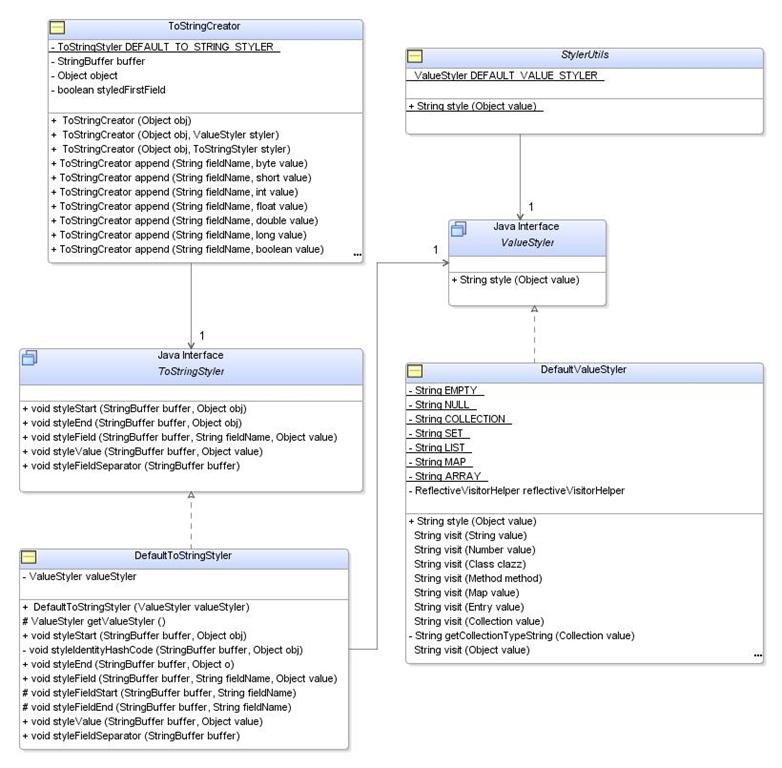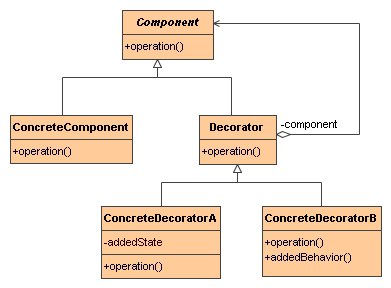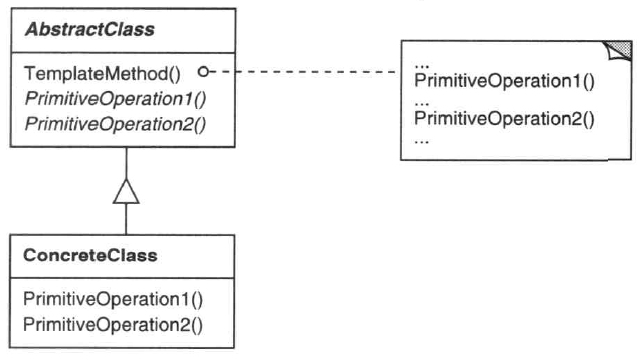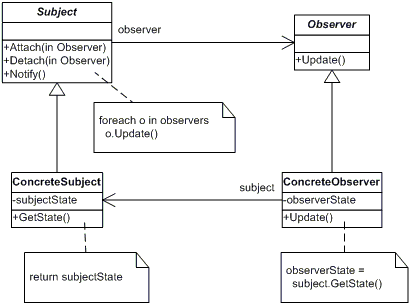《Programming Ruby中文版》前3部分我并不準(zhǔn)備細(xì)看,畢竟我接觸ruby也有一段時(shí)間了,只準(zhǔn)備快速地掠過一遍,查缺補(bǔ)漏;重點(diǎn)放在第3部分的核心內(nèi)容上,至于第四部分的參考手冊更多作為工具書了。僅在此記錄下一些值的注意的東西。
1.全局變量$_,默認(rèn)當(dāng)gets方法返回輸入的行時(shí),同時(shí)保存在全局變量$_,并且正則表達(dá)式如果作為條件語句(if或者while)時(shí)默認(rèn)是跟這個(gè)全局變量進(jìn)行匹配,而print參數(shù)為空時(shí)也是打印這個(gè)全局變量。這是早期ruby向perl語言學(xué)習(xí)的結(jié)果。可以看看這個(gè)例子:
while gets
if /Ruby/
print
end
end
這樣的風(fēng)格不值的提倡,全局變量的使用應(yīng)該盡力減少,ruby也在逐漸脫離perl主義的風(fēng)格
2.ruby中的單例模式:
class Logger
private_class_method:new
@@logger=nil
def Logger.create
@@logger=new unless @@logger
@@logger
end
end
log1=Logger.create
log2=Logger.create
puts log1.object_id
puts log2.object_id
3.ruby中的block作用:
1)迭代器,通常是內(nèi)部迭代器
2)事務(wù)Blocks,c#的using語句倒是跟這個(gè)有點(diǎn)像,其實(shí)就是讓對象自身負(fù)責(zé)資源的打開和關(guān)閉,這是通過Kernel.block_given?實(shí)現(xiàn)的,比如File.open方法,當(dāng)后面跟著一個(gè)block的時(shí)候,就會(huì)自動(dòng)關(guān)閉打開的文件資源,如果不是,就需要自己處理。
3)作為閉包,與javascript和其他語言中的閉包概念一致,一個(gè)例子:
def n_times(thing)
return lambda {|n| thing*n}
end
p1=n_times(23)
puts p1.call(3)
puts p1.call(2)
通過lambda方法將一個(gè)block轉(zhuǎn)為Proc對象,盡管參數(shù)thing在block被真正調(diào)用時(shí)已經(jīng)離開了作用范圍,但是仍然可以使用
4.ruby中數(shù)字的最大長度取決于系統(tǒng),這跟java,C#通過虛擬機(jī)規(guī)范的不同,數(shù)字類型的幾個(gè)常用迭代器:times,upto,downto,step,如:
2.step(10,2){|i| print i,' '} =>2,4,6,8,10
5.ruby中的字符串是8字節(jié)的序列,可以存儲(chǔ)可打印的字符和二進(jìn)制數(shù)據(jù)。比較有趣3種構(gòu)建字符串常量方式:%q(對應(yīng)于單引號定義的字符串),%Q(雙引號)以及here documents,比如:
s=<<END_OF_STRING
測試測試?yán)?br>END_OF_STRING
6.Range,書中翻譯為區(qū)間,我倒更喜歡范圍這個(gè)詞。區(qū)間的3個(gè)用途:
1)用作序列,最常見的,如1..2,a..z等,可以定義自己的區(qū)間,只要實(shí)現(xiàn)succ和<=>比較方法
2)作為條件,書中的例子很經(jīng)典:
while line=gets
puts line if line=~/start/..line=~/end/
end
#利用全局變量簡化為,不建議這樣寫
while gets
print if /start/../end/
end
3)作為間隔,看看某個(gè)值是否落入?yún)^(qū)間范圍內(nèi),使用===操作符比較
7.正則表達(dá)式,這是重頭戲。ruby中的perl風(fēng)格的正則表達(dá)式,其實(shí)也是內(nèi)建在ruby中的正則表達(dá)式對象的外部包裝,關(guān)鍵的就是兩個(gè)類Regexp類和MatchData類。一些peri程序員熟悉的記號:
$& 匹配的字符串
$` 匹配前的字符串
$' 匹配后的字符串
$1 第一個(gè)分組,$2,$3...類似
詳細(xì)的就不抄書了,正則表達(dá)式我在學(xué)習(xí)javascript的時(shí)候已經(jīng)系統(tǒng)地學(xué)過,倒是不感覺吃力。
8.在方法中定義可變長度參數(shù),只要參數(shù)前加*號即可,java1.5也已經(jīng)支持可變參數(shù),比如Object...obj。
另外,在方法中,將數(shù)組展開為參數(shù),可以在數(shù)組前加一個(gè)*號,比如:
def three(a,b,c)
print "this is #{a},#{b},#{c}"
end
three([1,2,3)]
#上面這樣調(diào)用報(bào)參數(shù)數(shù)目錯(cuò)誤,正確的用法如下:
three(*[1,2,3)] =>this is 1,2,3
將hash列表直接做為參數(shù),可能在2.0支持,目前采用的要求散列數(shù)組在正常的參數(shù)之后,并位于任何的block或者數(shù)組之前
9.ruby中的多線程:
1)ruby創(chuàng)建線程,見下面這個(gè)例子,開3個(gè)線程分別訪問3個(gè)站點(diǎn),并且對3個(gè)線程通過調(diào)用join方法,直到3個(gè)線程都結(jié)束,主線程才結(jié)束,來自書中例子:
require 'net/http'
pages=%w(www.javaeye.com www.sina.com.cn www.aygfsteel.com)
$proxy_addr = 'x.x.x.x'
$proxy_port = 80
threads=[]
for page_to_fetch in pages
threads<<Thread.new(page_to_fetch) do |url|
h=Net::HTTP.Proxy($proxy_addr, $proxy_port).new(url,80)
puts "Fetcing:#{url}"
resp=h.get('/',nil)
puts "Got #{url}:#{resp.message}"
end
end
threads.each{|thr| thr.join}
2)線程中如何共享變量?可以通過[]=簡單地把當(dāng)前線程看成一個(gè)散列表,這里沒有考慮同步問題:
count=0
threads=[]
10.times do |i|
threads[i]=Thread.new do
sleep(rand(0.1))
Thread.current["mycount"]=count
count+=1
end
end
threads.each{|t| t.join;print t["mycount"],", "}
puts "count =#{count}"
3)通過設(shè)置abort_on_exception,如果是true,未處理的線程異常將殺死所有正在運(yùn)行的線程,如果是false,則殺死當(dāng)前運(yùn)行的線程,其他線程繼續(xù)運(yùn)行。修改上面的例子查看下:
count=0
threads=[]
10.times do |i|
threads[i]=Thread.new(i) do |j|
raise "boom!" if j==4
sleep(rand(0.1))
Thread.current["mycount"]=count
count+=1
end
end
threads.each do |t|
begin
t.join
print t["mycount"],", "
rescue RuntimeError=>e
puts "Failed:#{e.message}"
end
end
puts "count =#{count}"
輸出(隨機(jī)的):
8, 1, 6, 3, Failed:boom!
2, 4, 7, 0, 5, count =9
在開頭加上:
Thread.abort_on_exception=true
殺死所有的運(yùn)行進(jìn)程,報(bào)出異常,而不會(huì)產(chǎn)生輸出。
4)通過線程的一系列方法:pass,join,value,stop來進(jìn)行線程的調(diào)度
5)互斥的實(shí)現(xiàn),與其他語言一樣,不外乎加鎖、信號量、隊(duì)列的方式。看看加鎖是如何做的,通過monitor庫的關(guān)鍵字synchronize實(shí)現(xiàn),如下面這個(gè)例子,兩個(gè)線程遞增同一個(gè)變量,似乎結(jié)果應(yīng)該是20000:
#require 'monitor'
class Counter#<Monitor
attr_reader:count
def initialize
@count=0
# super
end
def tick
# synchronize do
@count+=1
# end
end
end
c=Counter.new
t1=Thread.new{10000.times{c.tick}}
t2=Thread.new{10000.times{c.tick}}
t1.join;t2.join
print c.count
很遺憾,結(jié)果不會(huì)是20000,而是比它小的一個(gè)數(shù)值,這里的問題就是因?yàn)樵L問共享資源沒有進(jìn)行同步的緣故,使用monitor庫,請將上面代碼中的注釋去掉,可以得到正確的結(jié)果
使用monitor,不一定要使用繼承,也可以使用mixin,甚至:
lock=Monitor.new
t1=Thread.new{10000.times{lock.synchronize{c.tick}}}
還可以把特定的對象放入monitor,比如:
c=Counter.new
c.extend(MonitorMixin)
t1=Thread.new{10000.times{c.synchronize{c.tick}}}
 .
.
6)條件變量和隊(duì)列的方式不準(zhǔn)備抄書了,ruby中對線程的操作都是直接調(diào)用操作系統(tǒng)的命令,特別是*nix支持的非常好,可惜我對linux也是個(gè)初哥。
10.ruby中表達(dá)式很重要的一個(gè)特點(diǎn)是:任何表達(dá)式都有返回值,包括賦值語句、條件語句、循環(huán)語句之類。
1)ruby中對布爾表達(dá)式的規(guī)定是:任何不是nil或者常量false的值都為真
2)注意,在方法中調(diào)用訪問屬性的函數(shù),需要寫上調(diào)用者self,否則將處理為局部變量
3)defined?方法用于返回參數(shù)的描述,如果未定義,返回nil
4)邏輯表達(dá)式中,and和or的優(yōu)先級低于&&,||
5)ruby沒有for語句,因?yàn)閞uby通過內(nèi)建在對象中的迭代器提供了循環(huán)訪問的能力,最簡單的內(nèi)建迭代器:loop do ....end
6)只要你的類支持each方法,你就可以使用for ... in ..語句循環(huán)它
7)對循環(huán)可以使用break(打斷跳出),redo(從頭重新循環(huán),當(dāng)前迭代),next進(jìn)行調(diào)度。另外,還有retry,用于完全重新開始循環(huán)
8)while,until和for循環(huán)內(nèi)建到了ruby語言中,但沒有引入新的作用域:前面存在的局部變量可以在循環(huán)中使用,而循環(huán)中新創(chuàng)建的局部變量也可以在循環(huán)后使用。而被迭代器使用的block則不同,
在block中創(chuàng)建的局部變量無法在block外訪問。
11.ruby的異常處理
類似于java的try...catch...finnaly,ruby對應(yīng)的是begin...rescue...ensure...end,將產(chǎn)生異常的代碼放在這個(gè)塊中進(jìn)行處理。可以通過$!得到異常信息,或者提供局部變量名,我改寫了一下我的google在線翻譯機(jī),增加異常處理,并用exit代替break:
require 'net/http'
def translate
txt=STDIN.gets
exit if txt.strip=='e' or txt.strip=='exit'
temp=txt.split(' ')
if temp[1]=='1' or temp.size==1
langpair='en|zh-CN'
else
langpair='zh-CN|en'
end
#使用代理
begin
$proxy_addr = 'localhost'
$proxy_port = 80
response = Net::HTTP.Proxy($proxy_addr,$proxy_port).post_form(URI.parse("http://translate.google.com/translate_t"),{'text'=>temp[0],'langpair'=>langpair})
response.body =~ /<div id=result_box dir=ltr>(.*)<\/div>/
rescue StandardError =>e
$stderr.print "網(wǎng)絡(luò)錯(cuò)誤:"+e
else
result = $1
puts '翻譯內(nèi)容:'+temp[0]
puts 'google返回:'+result
puts '-------------------退出請打e或者exit---------------'
translate
end
end
translate
引發(fā)一個(gè)異常使用raise語句,重新引發(fā)當(dāng)前異常,如果沒有,就引發(fā)一個(gè)RuntimeError,常見使用方式:
raise InterfaceException,"keyboard failure",caller
其中的caller生成了棧的信息。另外,catch...throw語句用于在異常發(fā)生時(shí)從深度嵌套的結(jié)構(gòu)中跳轉(zhuǎn)出來。
12。關(guān)于模塊,作用有二:作為命名空間和Mixin機(jī)制。模塊的Mixin機(jī)制可以說是ruby的一個(gè)精華所在,通過Mixin,可以變相地實(shí)現(xiàn)了多重繼承,并且可以動(dòng)態(tài)地為類添加和刪除功能。這一部分注意兩點(diǎn):
1)模塊中定義的實(shí)例變量可能與包含模塊的類的實(shí)例變量產(chǎn)生名稱沖突。可以使用模塊一級的散列表,以當(dāng)前對象的ID做索引,來保存特定于當(dāng)前模塊的實(shí)例變量解決這個(gè)問題。比如:
module Test
State={}
def state=(value)
State[object_id]=value
end
def state
State[object_id]
end
end
class Client
include Test
end
c1=Client.new
c2=Client.new
c1.state='A'
c2.state='B'
puts c1.state
puts c2.state
2)是關(guān)于方法的查找路徑,順序是:當(dāng)前類-》類的mixin模塊-》超類-》超類的mixin,另外mixin的模塊,最后混入的同名方法將覆蓋前面混入的。
13.irb的配置和命令,今天發(fā)現(xiàn)irb原來也是可以玩出很多花樣的。記錄些有趣的:
1)可以使用按tab鍵兩次來自動(dòng)補(bǔ)全,要求加載irb/completaion庫。比如這樣啟動(dòng)irb:
irb -r irb/completion
或者進(jìn)入irb后手工require:
require 'irb/completation'
當(dāng)然,還有更好的方法,呆會(huì)介紹
2)子會(huì)話,在irb中使用irb可以創(chuàng)建子會(huì)話,通過命令jobs可以查看所有的子會(huì)話。創(chuàng)建子會(huì)話的時(shí)候指定一個(gè)對象,子會(huì)話的self將綁定該對象,比如:
irb 'test'
reverse
=>"tset"
length
=>4
self
=>"test"
irb_quit
3)在linux下可以通過配置.irbrc配置文件來進(jìn)行初始化定制,在windows環(huán)境你可以在ruby安裝目錄下的bin看到一個(gè)irb.bat文件,通過配置文件來定制irb,比如我們?yōu)閕rb增加ri和tab自動(dòng)補(bǔ)齊功能:
@echo off
goto endofruby
#!/bin/ruby
#
# irb.rb - intaractive ruby
# $Release Version: 0.9.5 $
# $Revision: 1.2.2.1 $
# $Date: 2005/04/19 19:24:56 $
# by Keiju ISHITSUKA(keiju@ruby-lang.org)
#
require "irb"
require 'irb/completion'
def ri(*names)
system(%{ri.bat #{names.map{ |name| name.to_s}.join(" ")}})
end
if __FILE__ == $0
IRB.start(__FILE__)
else
# check -e option
if /^-e$/ =~ $0
IRB.start(__FILE__)
else
IRB.setup(__FILE__)
end
end
__END__
:endofruby
"%~d0%~p0ruby" -x "%~f0" %*
4)常用命令:
exit,quit,irb_exit,irb_quit——退出
conf,context,irb_context——查看配置信息
irb <obj>——?jiǎng)?chuàng)建子會(huì)話,如果提供obj,作為self
jobs,irb_jobs——列出irb的子會(huì)話
irb_fg,fg n——切換子會(huì)話
kill n,irb_kill n——?dú)⑺酪粋€(gè)irb子會(huì)話
14.類的實(shí)例變量,類除了類變量、實(shí)例變量外,還有一個(gè)類的實(shí)例變量的概念:
class Test
#類的實(shí)例變量
@cls_var = 123
def Test.inc
@cls_var += 1
end
class<<self
attr_accessor:cls_var
end
end
Test.inc
Test.inc
15.子類竟然可以改變父類定義方法的訪問級別:
class Base
def aMethod
puts "Got here"
end
private :aMethod
end
class Derived1 < Base
public :aMethod
end
class Derived2 < Base
def aMethod(*args)
super
end
public:aMethod
end
d1=Derived1.new
d2=Derived2.new
d1.aMethod
d2.aMethod
不知道ruby是基于什么樣的考慮允許這樣的行為。







